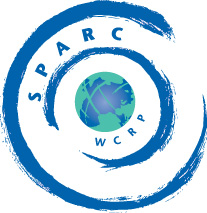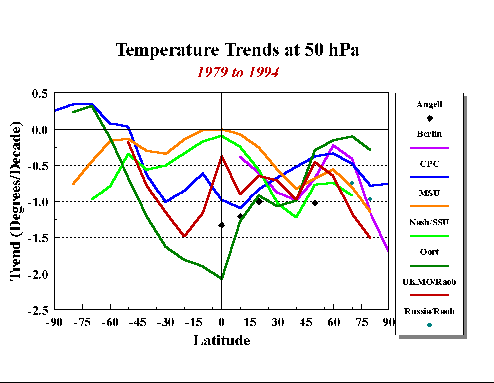 |
Stratospheric Processes And their Role in Climate
|
||||||||
| Home | Initiatives | Organisation | Publications | Meetings | Acronyms and Abbreviations | Useful Links |
![]()
 |
Stratospheric Processes And their Role in Climate
|
||||||||
| Home | Initiatives | Organisation | Publications | Meetings | Acronyms and Abbreviations | Useful Links |
![]()
Observations of atmospheric temperatures show that the stratosphere is cooling (see figure below). Model simulations show that this cooling trend is due to increases in greenhouse gases and decreases in ozone.
This group is working to:

Zonal-mean 50hPa temperature trends over the 1979-1994 period as obtained from different data sets. Included are radiosonde (Oort, Angell, Berlin, UKMO/Raob and Russian/Raob) and satellite records (MSU and SSU) and Climate Prediction Center (CPC) analyses.
The findings of the group have contributed to the 1998 WMO/UNEP Ozone Assessment and to a publication in Rev. Geophys. (39,1 pp71-122, 2001). The complete work will be published as a SPARC Report N° 3 in 2001.
More information on the activities and action plan of this initiative is available in the SPARC Implementation Plan.
A new approach to Atmospheric Profiling and Global Change Monitoring
using the GPS/GLONASS radio occultation technique,
A. Hauchecorne, SPARC newsletter 6 January 1999.
Radiosonde Observations and their use in SPARC-related Investigations,
D. Gaffen, SPARC newsletter 12, January 1999.
Trends in stratospheric temperatures, in: Scientific Assessment
of Ozone depletion: 1999,
M.L. Chanin and V. Ramaswamy, Global Ozone Research and Monitoring
Project - Report N°44. Chap 5, World Meteorological Organization,
5.1-5.59.
Stratospheric temperature changes: observations and model simulations,
V. Ramaswamy, M.L. Chanin, J. Angell, et al., Rev. Geophys., 39,1, pp71-122, 2001.
![]()
Last update: March 20, 2001